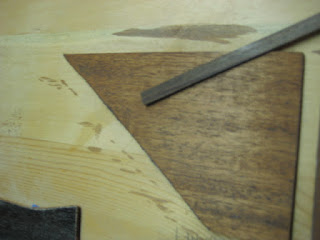I've been concerned about humidity lately. We had a big snow melt and some days of rain in the past week. I took some readings that were in the 50-percent range, and I was worried. So I borrowed this humidifier and let it run for a few days.

It seems to have helped, although not much. I'm not sure. After checking humidity dozens of times with my psychrometer, I think my initial reading may have been high. RH seems to be hovering in the mid-40's now, which is good. I've calibrated this cheap hygrometer, which I don't trust, but that still gives me an idea of when humidity is going up or down.

So, now that I believe I have a good idea of where I'm at humidity-wise, on with the build.
Here's the back being glued on.

The back is on! The boat is done.

I'm trimming the overhang with a chisel. Doing it this way makes cool patterns.

Here's the top sitting on top of "the boat."

It's starting to look more and more like a guitar.

Oooh...

Ahhh...

Ok, now imagine the two pics above with wood this color. Mmmmm...

Here's how the bracing has shaped up. It looks very very nice. I'm considering the bracing "done." If need be, it can be shaped further after the guitar is finished. I guess we'll see. Before gluing the top on, I just need to flatten the top part of the rim above the soundhole, and then I'll glue this on too, within the next few days.

My friends at mimf.com suggested that I slenderize the braces quite abit, so I did. Here, the upper part of the x has been triangle-ized. And I did that to all the major braces. It has a really nice tone...


















































